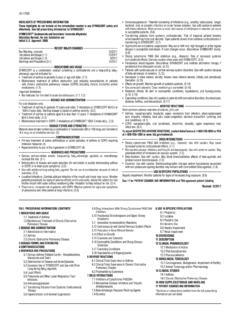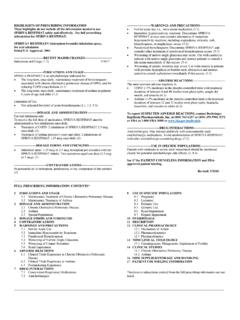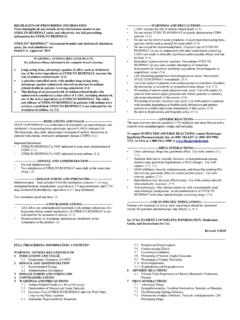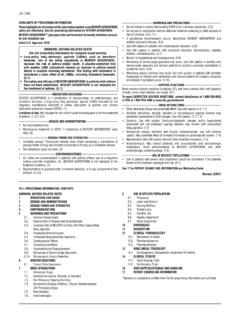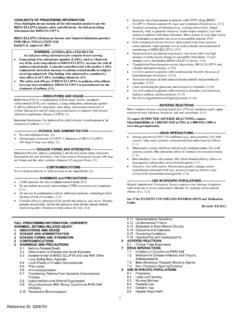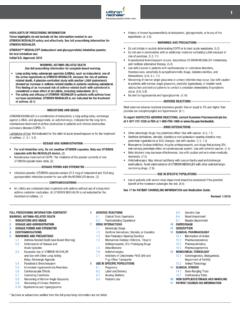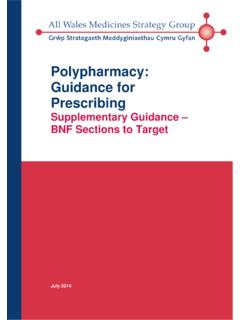Transcription of GUIDELINES FOR THE USE OF BENZODIAZEPINES …
1 GUIDELINES FOR THE USE OF BENZODIAZEPINES IN office PRACTICE IN THE STATE OF MAINE Introduction: This is an evidence based guideline for the use of BENZODIAZEPINES and related drugs in clinical office practice. Attached is a bibliography including earlier GUIDELINES on which this guideline is partially based and websites, reviews, and clinical studies that provide supporting evidence. This guideline applies to BENZODIAZEPINES used primarily as anxiolytics and sedative/hypnotics, and to the related Z drugs, such as zolpidem, which, while structurally different from the BENZODIAZEPINES , produce similar pharmacologic effects and have similar dependence and abuse potential.
2 The patient and his healthcare providers should agree on one provider to be the designated BZD prescriber for that patient. This designated prescriber will also be responsible for prescribing other medications with abuse potential, specifically central nervous system stimulants and narcotics, keeping in mind that the use of BZDs with long term narcotics and stimulants is not recommended.. Patients receiving a new prescription for a BZD for anxiety should be advised on nondrug therapies. Counseling referral will be strongly recommended.
3 Risks and side effects of BZDs should be reviewed, including the risk of dependence. In the patient over 65, these include the risk of falls, cognitive impairment, and interactions with other medications and medical conditions. Therefore BZDs should be used with caution in this age group. Because of delayed metabolism and increased risk of side effects, BZDs should be initiated at one half of the usual adult starting dose in the elderly patient. Prescription BZDs are often diverted. Care should be taken when prescribing to reduce the risk of diversion.
4 When initiating a course of BZD treatment, the clinician should keep in mind that some patients will have difficulty discontinuing the medication at the end of the acute treatment period. At the initiation of treatment, the patient should be advised explicitly regarding the duration of treatment. Exit strategies, such as a short taper or initiation of alternative treatments, may be discussed. If the patient's past medication use patterns or history of substance abuse suggest that BZD discontinuation may be problematic, then alternatives to BZDs should be utilized.
5 1 1. Contra indications to BZDs (particularly for long term use) a) Pregnancy and the patient at risk for pregnancy. BZDs are category D. If a hypnotic is necessary, Zolpidem (Ambien), which is category B, is preferred. Patients who conceive while on BZDs should be tapered off completely or to the lowest possible dose. b) Active substance abuse, including alcohol. c) Medical and mental health problems that may be aggravated by BZDs. These include fibromyalgia, chronic fatigue syndrome, other somatization disorders, depression (except for short term use to treat associated anxiety), bipolar disorder (except for urgent sedation in acute mania), ADHD, kleptomania, and other impulse control disorders.
6 They may worsen hypoxia and hypoventilation in asthma, sleep apnea, COPD, CHF, and other cardiopulmonary disorders. d) Patients being treated with opioids for chronic pain or replacement therapy for narcotic addiction. e) Grief reactions. BZDs are often used for short term treatment of insomnia in acute grief but should otherwise be avoided in treating grief reactions, as they may suppress and prolong the grieving process. 2. Indications for short term treatment with BENZODIAZEPINES a) The principal indication for BZDs is for short term treatment (2 to 6 weeks) of anxiety disorders.
7 These conditions include generalized anxiety disorder, phobias, PTSD, panic disorder, and severe anxiety associated with depression, while waiting for the full effect of the antidepressant. While BZDs have been studied and utilized to treat these conditions they are not first line therapy for any of them. However, it is acceptable to use BZDs as adjuncts during initial treatment while waiting for definitive therapy with long term medications and/or counseling to take hold. Continuing BZDs beyond 4 to 6 weeks will result in loss of effectiveness, the development of tolerance, dependence and potential for withdrawal syndromes, persistent adverse side effects, and interference with the effectiveness of definitive medication and counseling.
8 BZDs taken for more than 2 weeks continuously should be tapered rather than discontinued abruptly. b) Insomnia There is evidence for the effectiveness of BZDs and other hypnotics in the relief of short term (1 to 2 weeks), but not long term, insomnia. The treatment period should not exceed 2 weeks. The only significant clinical difference between older BZD hypnotics and the newer ones zolpidem (Ambien), zaleplon (Sonata), and eszopiclone (Lunesta) is the shorter half life of zolpidem and zaleplon (2 hours). All three have similar risks of dependence 2 and tolerance.
9 A search for an etiology of the insomnia should be undertaken. Sleep hygiene measures should be discussed. c) Muscle relaxant BZDs or other muscle relaxants are indicated for the short term relief (1 to 2 weeks) of muscular discomfort associated with acute injuries or flare ups of chronic musculoskeletal pain. BZDs may be combined with analgesics and non drug therapies but not with other sedatives, hypnotics, or other muscle relaxants. d) Other Indications: Urgent treatment of acute psychosis with agitation As part of a protocol for treating alcohol withdrawal Adjunctive treatment of withdrawal from other addictions (less accepted) Single dose treatment of phobias, such as flying phobia Seizures and a limited number of other neurological disorders Sedation for office procedures 3.
10 Indications for long term treatment with BENZODIAZEPINES . BZDs may be used for longer than 6 weeks in the terminally ill, in the severely handicapped patient, in certain neurological disorders (stiff person syndrome), and as an alternative to antipsychotics in the severely demented patient. 4. Approach to the patient already on long term BENZODIAZEPINES . There is no evidence supporting the long term use of BZDs for any mental health indication. At the time of BZD prescription renewal or medication review, the physician should discuss the risks of long term BZDs and the benefits of discontinuation (on cognition, mood, sleep, and energy level) and advise the patient to reduce or discontinue the BZD.

